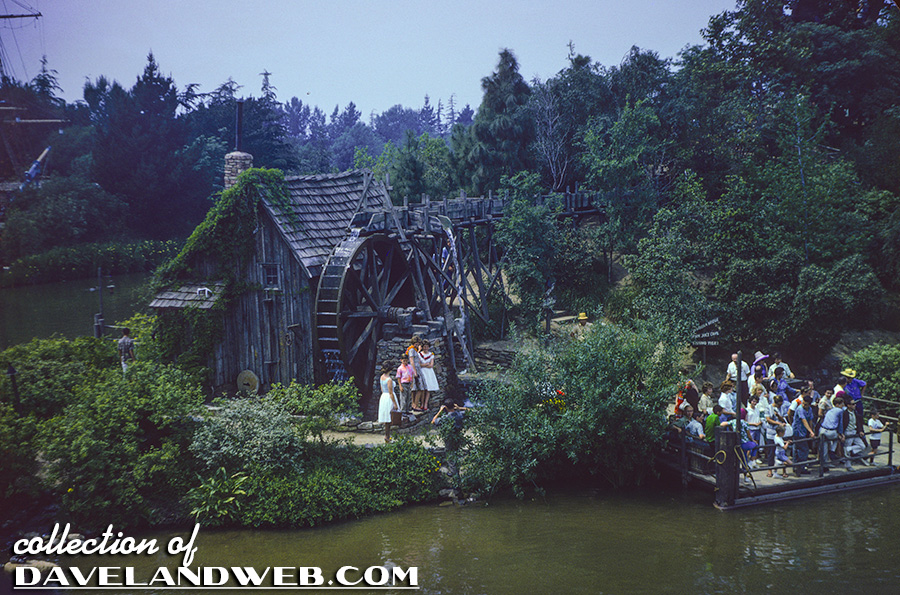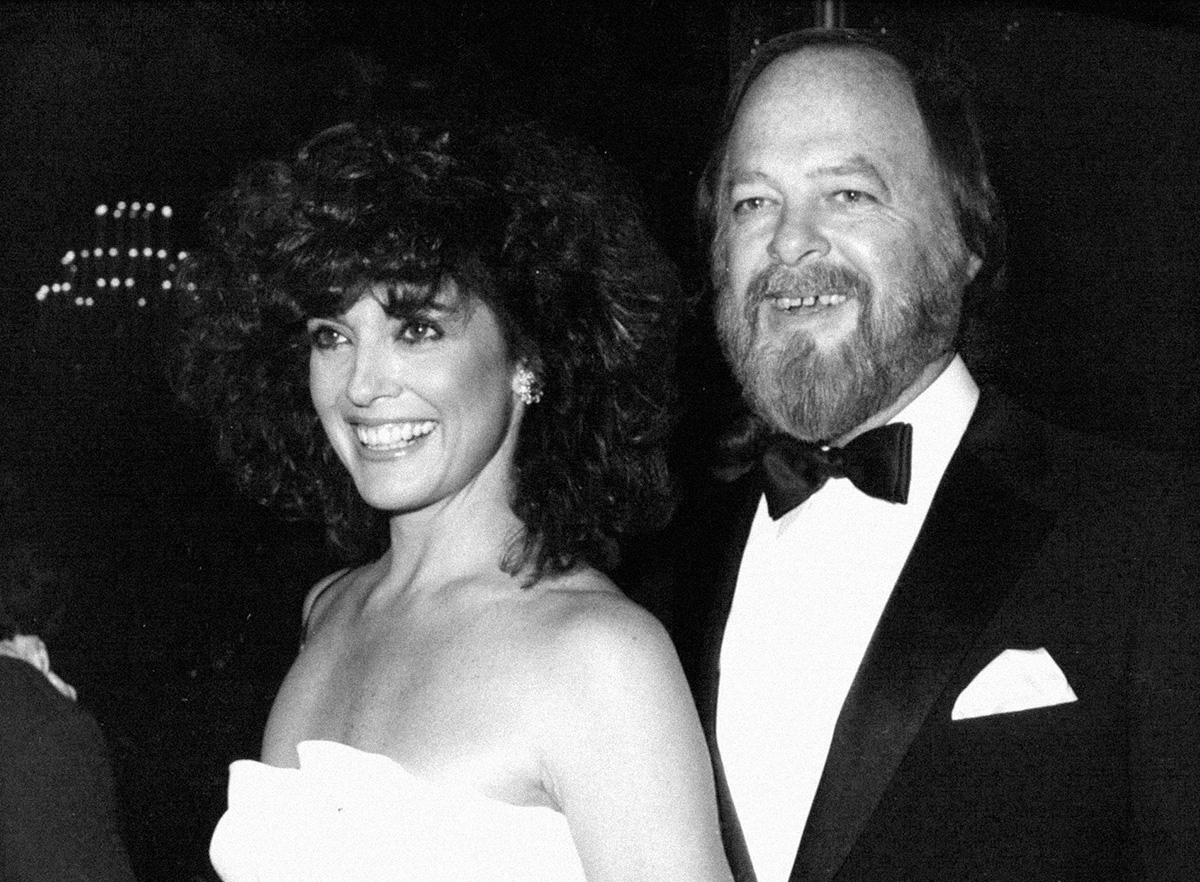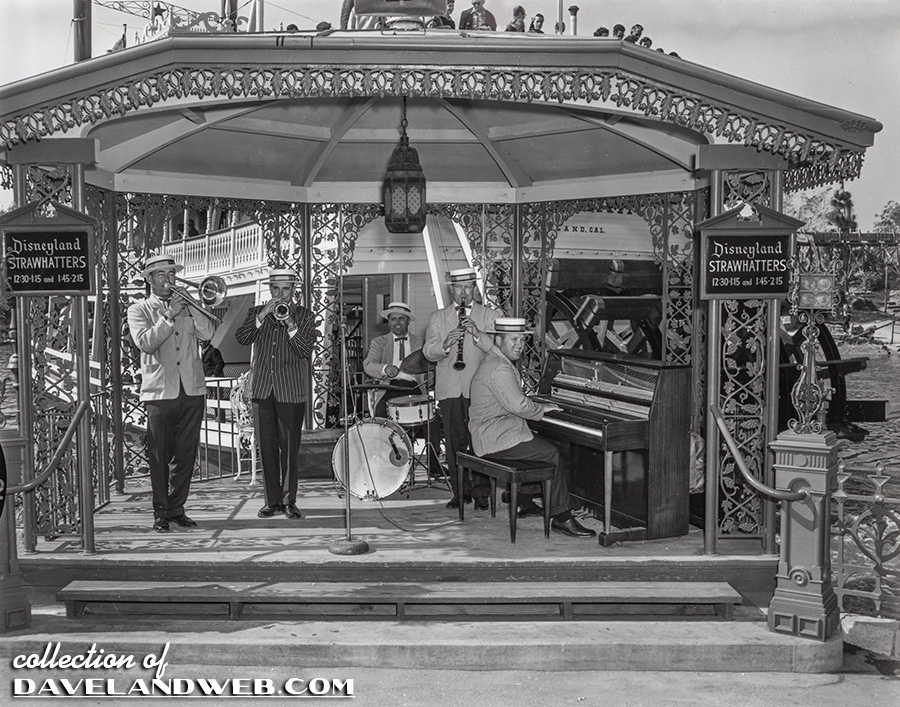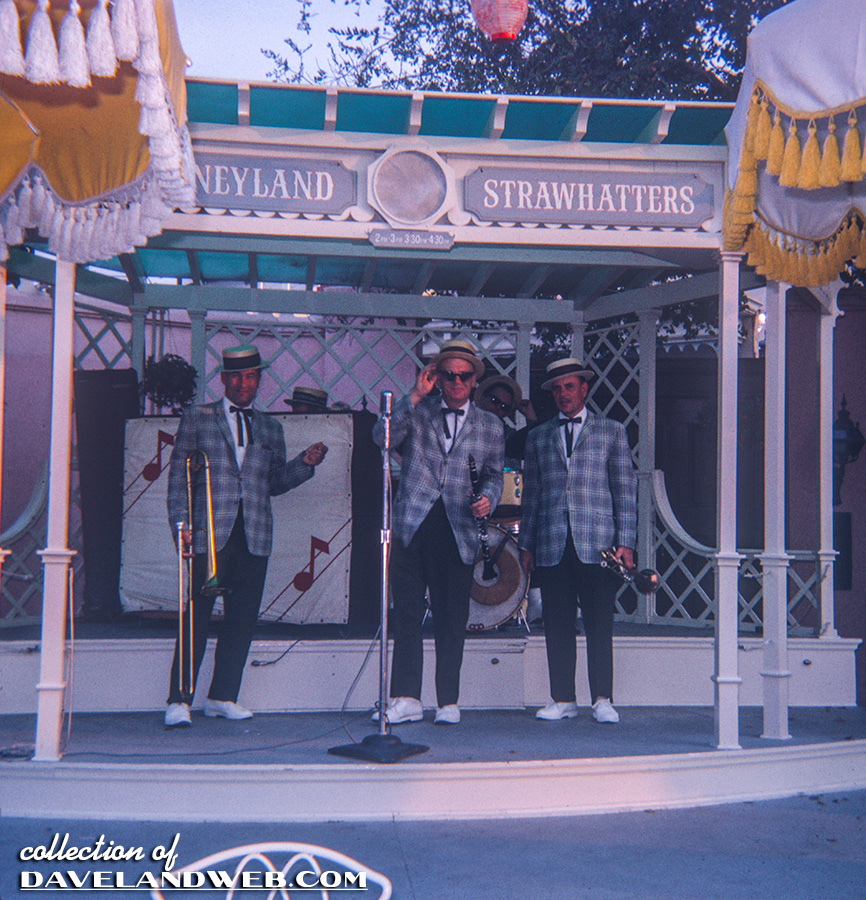
These days, it takes a lot to surprise me or pique my interest on all things Disneyland. Yes…I admit it. When it comes to vintage Disneyland, I’m fairly jaded. Yesterday, I was contacted by someone who was looking for background information on the album cover shown above. Originally released on August 15, 1972, the photo for John Fahey’s Of Rivers and Religion is from the CD reissue. At first glance, it appears to be a vintage Daguerreotype from the Civil War era, portraying a group of slaves on a raft with an Old Mill behind them. For sharp-eyed Disneyland nutz (like myself), you can see that it was snapped on the Rivers of America with Tom Sawyer’s Island behind them. The liner notes shown below…

confirm that the photo was taken at Disneyland, with art direction and photography by Ed Thrasher.

Don’t believe it? Compare with this photo from my collection taken a few years earlier. Even the vegetation on the Old Mill matches.

The raft and the red buckets match, too. The photo was taken before Photoshop was available, and it is too good to be a composite from the time. So now that we know it’s genuine, what’s the story behind it?

I contacted my usual sources and they were all stumped. One was genuinely interested and wanted me to do a post; the other didn’t seem to care too much. Maybe he had just woken up and hadn’t had his Wheaties yet. I took the advice of the former and am now creating this post!
For the photographer, here’s what I found. What a pedigree! Edited from his August 2006 L.A. Times obit:
When Frank Sinatra ended his two-year retirement at 57 in 1973, Warner Bros. Records art director Ed Thrasher came up with the perfect title for the legendary singer’s comeback album. The album — for Warner’s Reprise Records label — with its cover photograph by Thrasher showing a relaxed and grinning Sinatra during a recording session, was called “Ol’ Blue Eyes Is Back.” “Ed showed the artwork to Frank, and he just flipped, as we all did,” recalled Joe Smith, former president of Warner Bros. Records. “Frank thought ‘Ol’ Blue Eyes Is Back’ was a great phrase, and it later turned out to be an ad hook when Frank was out on the road again.”As an art director, Smith said, “Ed had the talent for getting along with the talent, especially with a Frank Sinatra, who could get very cranky. With Ed, Frank was a pussycat. He never gave Ed any trouble about the covers.” Thrasher, who worked on hundreds of major albums as an art director, died of cancer Aug. 5 at his Big Bear Lake home, said his son, Jeff. He was 74. Thrasher received 12 Grammy Award nominations as an art director from 1962 to 1974. Joining Warner Bros. Records in 1964 after having been an art director at Capitol Records, Thrasher was the art director on a long string of albums from major artists. Among them: the Jimi Hendrix Experience’s “Are You Experienced?,” Joni Mitchell’s “Song to a Seagull,” the Grateful Dead’s “Anthem of the Sun,” Sinatra’s “My Way,” Van Morrison’s “Tupelo Honey,” Earth, Wind & Fire’s “Earth, Wind & Fire,” the Doobie Brothers’ “Stampede,” Commander Cody’s “We’ve Got a Live One Here,” Bill Cosby’s “Wonderfulness” and Richard Pryor’s “Was It Something I Said?” Thrasher did the photography for many of the albums, in addition to working on print ads and posters. Said Stan Cornyn, a former Warner Bros. Records executive vice president who was director of creative services when he worked with Thrasher in the 1960s and ‘70s, “He was skilled and flexible, and flexibility is not a bad attitude to have when you’re dealing with rock ‘n’ roll stars.” Thrasher, Cornyn said, was able to “handle whatever came along,” because of his “charm, sense of humor, and he knew his job.” Thrasher’s humor extended to occasional practical jokes. Noticing that the company’s top executive routinely made a 10 a.m. stop at the sole upstairs restroom in the old Warner Bros. Records building, Thrasher installed a life-size dummy — with shoes, socks and pants pulled down to the ankles — on the toilet in the restroom’s only stall. Thinking the stall was being used, the executive made repeated trips to the restroom, Cornyn said, before “he finally got down on his knees and figured it out.” “This was Ed’s idea of a good time, and I must say it was shared by all,” Cornyn said. After leaving Warner Bros. Records in 1979, Thrasher formed Ed Thrasher and Associates, an advertising company that created art for films, including Prince’s “Purple Rain” and Mel Gibson’s “Mad Max Beyond Thunderdome.” Thrasher studied art and illustration at Los Angeles Trade Technical College and the County Art Institute before being hired as an assistant in the art department at Capitol Records in 1957. Thrasher, whose 22-year marriage to actress Linda Gray ended in divorce, is survived by his son; his daughter, Kehly Sloane; two grandchildren; and his sister, Marilyn Ball.

Yes. That Linda Gray. The one who played Sue Ellen Ewing on “Dallas.”
According to allmusic.com:
On Of Rivers & Religion, the ensemble included many of the New Orleans players who performed on Walt Disney's Song of the South film soundtrack.
The musicians listed in the credits on Fahey’s album are:
John Fahey – guitar
Chris Darrow – second guitar, dobro, fiddle, mandolin
Joel Druckman – double bass
Jack Feierman – trumpet
Ira Nepus – trombone
Joanne Grauer – piano, calliope
Nappy La Mare – banjo
Alan Reuss – banjo
Joe Darensbourg – clarinet
While I was unable to find the names of the musicians who specifically played on the “Song of the South” soundtrack, I did find a number of Disneyland connections for Fahey’s musicians. Chris Darrow put together a bluegrass band called the Dry City Scat Band which played at Disneyland during the summer of 1964. On Ira Nepus’ website, he states: “I have been a professional musician for over 40 years, beginning at age 17 while I was still in high school and working at Disneyland and numerous recording sessions.” Nappy La Mare played for the Straw Hat Strutters and with Bob Crosby at Disneyland. Alan Reuss played rhythm guitar for the song “Grim Grinning Ghosts” at Disneyland’s Haunted Mansion. Joe Darensbourg also played at Disneyland according to Disney History Institute with the Dixie Flyers in 1960.


For a taste of Fahey’s album, you can listen to this track on YouTube:
That’s all I could find for now. Unfortunately, the details of the photo shoot itself are still unknown to me. I think it’s fairly safe to say that a photo like that (and its story) is not something the Disney Corporation is going to discuss any time soon. If you have any information, please drop it in the comments section!
See more photos at my main website.

7 comments:
Another fascinating post.
I've heard of Ed Thrasher, but not Christopher Whorf - who was an art director, famously designing the graphics for Neil Bogart's Casablanca Record & FilmWorks and Boardwalk Entertainment - among many other projects.
But I certainly know of Peter Whorf, who was the art director at A&M Records and ABC/Dunhill Records, prior to starting his own design firm. He's perhaps best-known for creating one of the most memorable LP covers of all time - the album cover for the Herb Alpert's Tijuana Brass - Whipped Cream & Other Delights. Oddly enough, there appears to be no family connection between Chris and Peter...
[All of this is very interesting, I suppose...] but it doesn't help answer the questions as to how and who was involved with granting permission etc. for the cover, seen here.
Thanks, Dave.
Nanook - I noticed a few typos on the names listed on the album cover, so they could have screwed up Whorf’s first name, too.
This album cover was something I thought about on and off for 20+ years. I am 50 years old now. It will be nice if we find out more over time. So far from my research the explanations vary greatly, say, from a musical band in "reconstruction era" costume to a hired photoshoot for the album cover itself. As far as what it actually depicts in any detail that still seems unclear as well. As mentioned in the post it would be hard to imagine Disney explaining this picture today and when I think back to the history of Indian Village with hired tribal members this image has none of the so-called "celebration" of that culture, whether one agrees or not with how it was all orchestrated in the end. This image is indeed more haunting both in terms of the slavery of our past but more acutely in terms of how these images get reconstructed and for what purposes now.
On a personal level having gone to Disneyland as much as I did as a kid this image always resonated with my preoccupation with the "construction" of the park. I mean this literally as a kid but also as I got older wondering more deeply about the cultural constructions around identity and what not. The rafts pictured above, for example, always had a rudder which flopped in the jets of the boat motor because the visible rudder was indeed made of rubber! This was the sort of thing that got me thinking as a kid about how all this stuff was designed and how ultimately none of it was what it seemed to be! Much like this album cover indeed. It really isn't at all what it seems to be and yet this fits very nicely with much of Fahey's own approach to musical appropriation as well as his techniques of often spinning his own creative stories and webs of so-called misinformation.
The Fahey album The Great San Bernardino Birthday Party & Other Excursions is a good example of this kind of avant-garde folklore which he so carefully curated over the years. He was also a huge proponent of saving the Desert Tortoise. And like so many other biographical notes, which can be found in the book How Bluegrass Music Destroyed My Life, he often seemed more tuned in with "history construction" and not necessarily any single interpretation etc. As some of you will know Orange County's history is more diverse and weirder than most are willing to admit, for instance Phillip K. Dick living in Santa Ana at the end of his life or all of those really terrible Wally George broadcasts that no matter how one looks at it now really was a sign of what was to come, oof.
But let's see what the Internet might bring now that this cover is reaching a different audience but I will say none of my contacts who are more familiar with Fahey himself have a clear explanation of the image's provenance as well.
Mason - Thank you so much for bringing this album cover to my attention! It has been one of the most interesting rabbit holes a reader has turned me onto!
Dave
Thanks for posting it and I am just glad it's not just in my brain now but all of yours as well!
I was a friend of John Fahey's and a young lawyer in 1972. John had told me of the album he had completed but he was stumped for the cover art. I suggested we go down to Disneyland in Anaheim and either use the steamboat on the Mississippi River ride or Tom Sawyer Island. John, the art director and I all went down to Disneyland. We agreed on the Tom Sawyer ride and we hired some extras on the spot and shot the photo that now graces the front of the album. And my name is on the back, crediting me for location concept.
PS: Now I am an old lawyer.
Indeed, I may have tried contacting you through another contact! I am glad to see your comments here. This is a good bit of news.
Post a Comment